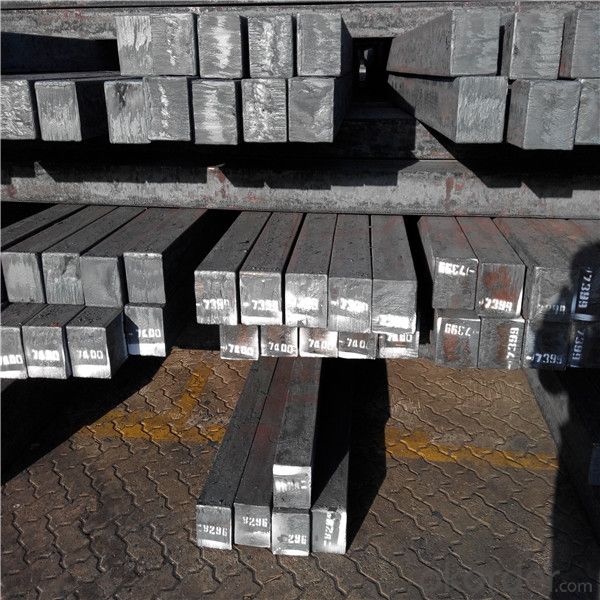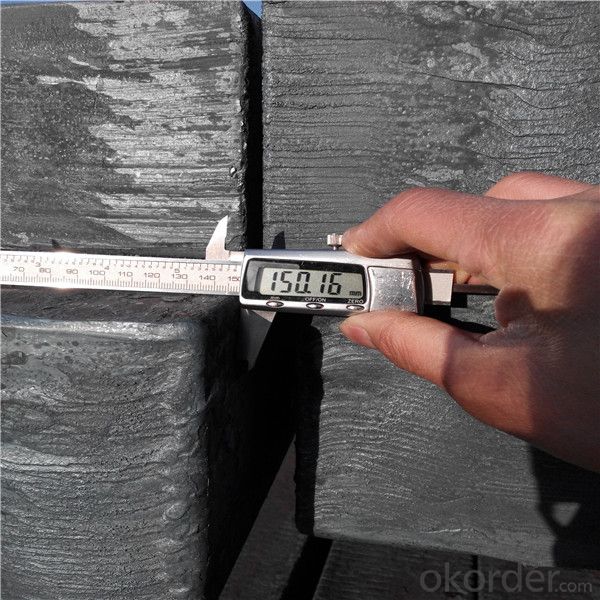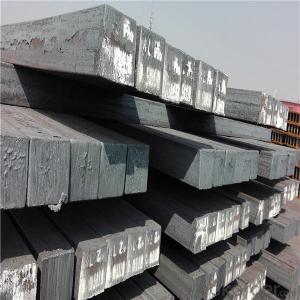Grade Q215 super square steel billet form China
- Loading Port:
- Guangzhou
- Payment Terms:
- TT OR LC
- Min Order Qty:
- 1000 m.t.
- Supply Capability:
- 17172 m.t./month
OKorder Service Pledge
OKorder Financial Service
You Might Also Like
Item specifice
Billets, or ingots (as they sometimes referred to), are not of practical use until they have been formed
into more functional shapes and sizes. While they have already been put in the furnace, they still
require a series of shaping and molding procedures such as hot and cold working, milling and cutting
before they are sold in hardware stores, or used for different applications. The unformed billets,
however, can be used in striking currency such as coins and as reserves, similar to gold bars.
Qaulity:own factory, stable quality
Tolerance: Strictly according to the G/B and JIS standard
Delivery time: within 45 days after receiving the L/C or advanced T/T payment.
Price term: FOB/CIF/ CFR according to clients requirements
Payment terms: 100%Irrevercable L/C at sight or T/T
Gade:
Standard | C(%) | Mn(%) | S(%) | P(%) | Si(%) |
Q195 | ≤0.12 | ≤0.50 | ≤0.040 | ≤0.035 | ≤0.30 |
Q235 | ≤0.20 | ≤1.40 | ≤0.045 | ≤0.045 | ≤0.35 |
Q275 | ≤0.22 | ≤1.50 | ≤0.045 | ≤0.045 | ≤0.35 |
20MnSi | 0.17-0.25 | 1.2-1.6 | ≤ 0.050 | ≤ 0.050 | 0.40-0.80 |
3SP | 0.14-0.22 | 0.40-0.85 | ≤ 0.050 | ≤ 0.040 | 0.05-0.15 |
5SP | 0.28-0.37 | 0.50-1.00 | ≤ 0.050 | ≤ 0.040 | 0.15-0.30 |



Our service :
We have a plant and professional team to provide our best service, from the start of production until the
loading into the vessel, we have a complete quality follow up procedure, to assure our products arrives to the customer with satisfaction. Welcome new and old customers
to contact us for future business relationships! We will give you a surpise price.
Packing :
Within 30 days
1.Standard export package
2.In bundles with steel strips
3.As the requirements of the customers
FAQ:
Q: What is payment terms?
A: FOB 30% T/T IN ADVANCE AS DEPOSIT AND 70% T/T BEFORE SHIPMENT
CIF and CFR 30% T/T IN ADVANCE AS DEPOSIT AND 70% T/T AS THE COPY OF B/L OR L/C AT SIGHT
Q:How to guarantee the quality of the products?
A:We have established the international advanced quality management system,every link from raw material
to final product we have strict quality test;We resolutely put an end to unqualified products flowing into the market.
At the same time, we will provide necessary follow-up service assurance.
Q:How long can we receive the product after purchase?
A :In the purchase of product within three working days, We will arrange the factory delivery as soon as possible.
The pecific time of receiving is related to the state and position of customers.
- Q:What is the role of steel billets in the construction of residential buildings?
- Residential building construction heavily relies on steel billets, which have a crucial function. These elongated steel bars, with their rectangular shape, act as the primary raw material for producing different structural components used in the construction process. One major application of steel billets lies in the creation of reinforced concrete structures. Due to its exceptional strength and durability, reinforced concrete finds extensive use in building foundations, columns, beams, and slabs. To enhance the structural integrity of the building and provide tensile strength, steel billets are employed in the manufacturing of rebar. This rebar is then embedded within the concrete, allowing the building to withstand external forces like wind, seismic activity, and its own weight. Moreover, steel billets find utility in the production of steel beams and columns. These components play a crucial role in supporting the building's weight and transferring loads from the upper floors to the foundation. Steel beams offer superior strength and rigidity, enabling the construction of open and spacious interiors without the need for excessive support walls. This not only provides design flexibility but also maximizes the usable space within residential buildings. Steel billets also contribute to the construction of stairs, handrails, and balconies. These architectural elements necessitate materials with high strength to ensure the structure's safety and longevity. By providing the necessary strength and stability, steel billets enable safe and secure access to different areas of the building. In conclusion, steel billets are of utmost importance in residential building construction, serving as the raw material for various structural components. From reinforced concrete structures to steel beams, columns, and other architectural elements, steel billets play a vital role in ensuring the strength, durability, and overall safety of residential buildings.
- Q:Can steel billets be coated for improved aesthetic appearance?
- Improving the aesthetic appearance of steel billets is possible by applying coatings. These coatings, including paints, powder coatings, and plating, can enhance the visual appeal of the steel billets. They serve multiple purposes such as providing a decorative finish, protecting against corrosion, and increasing the overall durability of the steel billets. Moreover, these coatings can be tailored to meet specific aesthetic demands, allowing for increased design flexibility in terms of colors, textures, and patterns. Consequently, coating steel billets is a widely adopted practice across various industries such as construction, automotive, and consumer goods, to achieve a better aesthetic appearance.
- Q:Can steel billets be used in high-temperature applications?
- Yes, steel billets can be used in high-temperature applications. Steel is known for its high strength and heat resistance, which makes it suitable for various high-temperature environments such as furnaces, boilers, and industrial ovens. Additionally, steel can retain its mechanical properties and structural integrity even at elevated temperatures, making it a reliable choice for such applications.
- Q:How are steel billets used in the production of structural steel?
- Structural steel production relies heavily on steel billets, which are indispensable for the manufacturing process. These semi-finished steel products serve as the initial material, from which the transformation begins. To initiate the production of structural steel, scrap steel is melted in a high-temperature furnace. Once the steel reaches its liquid state, it is poured into molds that give it a solid, rectangular shape with a uniform cross-section. After the billets solidify, they are transported to a rolling mill. In this facility, the billets are reheated to a specific temperature and passed through a series of rollers. With each pass, the billets progressively undergo size and shape reduction. This crucial step, known as hot rolling, refines the mechanical properties of the steel. The hot-rolled billets then proceed to various techniques, including forging, extrusion, or casting, to achieve specific shapes and sizes required for structural applications. These techniques enable the transformation of the billets into beams, columns, plates, or other components necessary for construction projects. Once the desired shape is attained, the structural steel undergoes several treatments to enhance its strength, durability, and resistance to corrosion. Heat treatment, surface coating, and additional alloying elements may be employed for this purpose. Ultimately, the finished structural steel products find application in a wide range of projects, including the construction of buildings, bridges, and infrastructure. The consistent size and shape of the steel billets ensure that the resulting components possess the necessary strength, stability, and structural integrity to withstand the loads and stresses they will encounter. In conclusion, the importance of steel billets in structural steel production cannot be overstated. They serve as the fundamental material that undergoes various processes to achieve the desired shapes and sizes required for construction. The quality and uniformity of the billets are paramount in ensuring the strength and durability of the final structural steel products.
- Q:What are the main properties of steel billets?
- Steel billets serve as the initial material for various steel products and possess several important properties that make them suitable for further shaping and processing. To begin with, steel billets demonstrate a high level of strength and durability. This is primarily attributed to the composition of steel, which consists mainly of iron with small amounts of carbon and other elements. This composition provides steel billets with exceptional mechanical properties, including high tensile strength and resistance to deformation. Moreover, steel billets exhibit favorable heat transfer properties. Steel is renowned for its efficient heat conductivity, making it an ideal material for applications requiring thermal conductivity, such as the production of automotive parts or construction materials. Furthermore, steel billets possess excellent machinability. Machinability refers to the ease with which a material can be shaped or formed using various machining processes. Steel billets can be easily cut, drilled, and shaped into desired forms, enabling efficient processing and fabrication. Additionally, steel billets display superb weldability. Steel is known for its compatibility with welding processes, enabling the joining of different steel components or the repair of damaged steel structures. This property is crucial in numerous industries, including construction, automotive, and shipbuilding. Lastly, steel billets have a high level of recyclability. Steel is one of the most widely recycled materials globally, with a significant portion of steel production derived from recycled steel. This environmentally friendly aspect makes steel billets an excellent choice as they can be recycled and repurposed multiple times without losing their properties. In conclusion, steel billets possess high strength and durability, favorable heat transfer properties, excellent machinability and weldability, and a high level of recyclability. These properties establish steel billets as a versatile and extensively used material in various industries, spanning from construction and manufacturing to automotive and aerospace.
- Q:What are the main factors affecting the quality of steel billets?
- There are several main factors that can significantly affect the quality of steel billets. These factors include the composition of the steel, the temperature and time of the heating process, the cooling rate, and the presence of impurities. Firstly, the composition of the steel plays a crucial role in determining its quality. The presence of certain elements such as carbon, manganese, and silicon can affect the mechanical properties of the steel, including its strength and hardness. The proper control and balance of these alloying elements are essential to ensure the desired quality of the steel billets. Secondly, the temperature and time of the heating process during the production of steel billets are critical factors. The heating process must be carefully controlled to achieve the optimal temperature for the desired transformation of the microstructure. Overheating or underheating can lead to the formation of undesirable phases or an inconsistent microstructure, which can negatively impact the quality of the billets. The cooling rate is another important factor affecting the quality of steel billets. The cooling process needs to be controlled to achieve the desired microstructure and mechanical properties. Too rapid cooling can result in the formation of brittle phases or residual stresses, while slow cooling can lead to coarse-grained structures with reduced strength. Furthermore, the presence of impurities in the steel can significantly affect its quality. Impurities such as sulfur, phosphorus, and non-metallic inclusions can decrease the mechanical properties and promote the formation of defects in the steel billets. Therefore, strict control of the raw materials and the implementation of effective refining techniques are necessary to minimize the presence of impurities. In conclusion, the main factors affecting the quality of steel billets are the composition of the steel, the temperature and time of the heating process, the cooling rate, and the presence of impurities. By carefully controlling and optimizing these factors, steel manufacturers can produce high-quality billets that meet the desired specifications and performance requirements.
- Q:How are steel billets used in the energy and power generation industry?
- Steel billets are an essential component in the energy and power generation industry due to their strength, durability, and versatility. These cylindrical castings of steel are used in various applications within this industry. One of the primary uses of steel billets in the energy and power generation industry is for the construction of power plants and infrastructure. Billets are commonly used to manufacture heavy-duty equipment, such as turbines, generators, and boilers, which are crucial for converting various energy sources into electricity. The high strength and resilience of steel billets ensure that these structures can withstand the harsh operational conditions and maintain their integrity over an extended period. In addition to the construction of power plants, steel billets are also used in the manufacturing of transmission and distribution systems. These systems, including power lines, transformers, and substations, require sturdy materials to support the efficient transmission and distribution of electricity. Steel billets are often used to produce the poles, towers, and other structural components that form the backbone of these systems, ensuring their reliability and long-term functionality. Moreover, steel billets find application in the production of equipment used for renewable energy generation. For instance, in wind energy, billets are used to manufacture the towers on which wind turbines are mounted. These towers must withstand the forces exerted by wind and support the weight of the turbine, and steel billets provide the necessary strength and stability for this purpose. Furthermore, steel billets are employed in the fabrication of equipment for oil and gas exploration, extraction, and refining. In this industry, billets are utilized to produce pipes, valves, and other components that are essential for transporting and processing petroleum and natural gas. The robustness of steel billets ensures the integrity and safety of these systems, even in demanding conditions such as high-pressure and high-temperature environments. In summary, steel billets play a vital role in the energy and power generation industry by serving as the building blocks for the construction of power plants, transmission systems, renewable energy infrastructure, and oil and gas facilities. Their strength, durability, and versatility make them an indispensable material for ensuring the reliability, efficiency, and safety of these critical energy systems.
- Q:How do steel billets come out?
- Two, pig iron and scrap steel1, smelting equipmentA, BOF: top and bottom blowing, blowing, now is widely used in pure oxygen top blown converterB, open hearth:C, electric steelmaking:
- Q:What are the main factors that affect the international trade of steel billets?
- The main factors that affect the international trade of steel billets include global demand and supply dynamics, import/export policies and regulations, currency exchange rates, transportation costs, political stability, and trade barriers such as tariffs and quotas. Additionally, factors like quality standards, technological advancements, and market competition also influence the international trade of steel billets.
- Q:How are steel billets used in the production of oil and gas pipelines?
- Steel billets are a crucial component in the production of oil and gas pipelines. They serve as the starting material for the manufacturing process of these pipelines. Steel billets are essentially semi-finished steel products that are often in a rectangular or square shape. To produce oil and gas pipelines, the steel billets undergo a series of manufacturing processes. First, the billets are heated to high temperatures in a furnace. This process, known as billet heating, allows the steel to become more malleable and easier to shape. Once the billets reach the desired temperature, they are then passed through a series of rollers to transform their shape into a cylindrical form. This process is called hot rolling, and it helps to further enhance the mechanical properties of the steel, making it stronger and more durable. After hot rolling, the steel is typically subjected to a process called quenching and tempering. Quenching involves rapidly cooling the steel to increase its hardness, while tempering is a heat treatment process that reduces the brittleness of the steel, making it less prone to cracking. Once the steel billets have been transformed into cylindrical pipes through these processes, they are then welded together to form the final pipeline. Welding ensures the integrity and strength of the pipeline, allowing it to withstand the high pressures and harsh environments associated with the transportation of oil and gas. Overall, steel billets play a vital role in the production of oil and gas pipelines. They serve as the foundation material, undergoing various manufacturing processes to transform them into durable, high-strength pipes that can efficiently transport oil and gas across vast distances.
1. Manufacturer Overview |
|
|---|---|
| Location | |
| Year Established | |
| Annual Output Value | |
| Main Markets | |
| Company Certifications | |
2. Manufacturer Certificates |
|
|---|---|
| a) Certification Name | |
| Range | |
| Reference | |
| Validity Period | |
3. Manufacturer Capability |
|
|---|---|
| a)Trade Capacity | |
| Nearest Port | |
| Export Percentage | |
| No.of Employees in Trade Department | |
| Language Spoken: | |
| b)Factory Information | |
| Factory Size: | |
| No. of Production Lines | |
| Contract Manufacturing | |
| Product Price Range | |
Send your message to us
Grade Q215 super square steel billet form China
- Loading Port:
- Guangzhou
- Payment Terms:
- TT OR LC
- Min Order Qty:
- 1000 m.t.
- Supply Capability:
- 17172 m.t./month
OKorder Service Pledge
OKorder Financial Service
Similar products
New products
Hot products
Related keywords





























